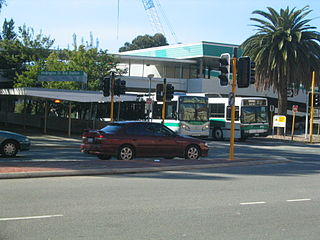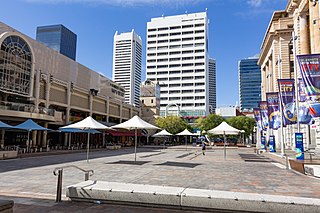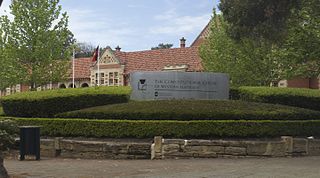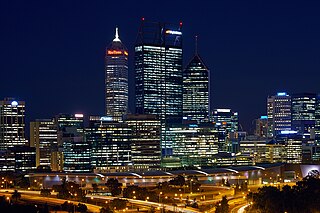Related Research Articles

Perth railway station is the largest station on the Transperth network, serving the central business district of Perth, Western Australia. It serves as an interchange between the Armadale, Fremantle, Joondalup, Mandurah and Midland lines as well as Transwa's Australind service.

Wellington Street bus station was a Transperth bus station located next to Perth railway station in the Perth central business district, Western Australia from 1973 until 2014. It was demolished to make way for Perth Busport.

Westrail was the trading name of the Western Australian Government Railways (WAGR) from September 1975 until December 2000, when the WAGR's freight division and the Westrail name and logo were privatised.
Western Australian Government Railways (WAGR) was the operator of railway services in the state of Western Australia between October 1890 and June 2003. Owned by the state government, it was renamed a number of times to reflect extra responsibility for tram and ferry operations that it assumed and later relinquished. Its freight operations were privatised in December 2000 with the remaining passenger operations transferred to the Public Transport Authority in July 2003.

Burswood is an inner southeastern suburb of Perth, Western Australia, located immediately across the Swan River from Perth's central business district (CBD). Its local government area is the Town of Victoria Park. Burswood is the location of the State Tennis Centre, Perth Stadium, Belmont Park Racecourse, and the Crown Perth casino and hotel complex.

The Midland Railway of Western Australia (MRWA) was a railway company that built and operated the Midland line in Western Australia. It was listed on the London Stock Exchange. Although having its headquarters in London, it had no association with the English Midland Railway.

The Canning River is a major tributary of the Swan River in the South West Land Division of Western Australia. It is home to much wildlife including dolphins, pelicans, swans and many other bird species.

Forrest Place is a pedestrianised square located within the CBD of Perth, Western Australia. The street was created in 1923, and has a history of being a focal point for significant political meetings and demonstrations.

The Goldfields Water Supply Scheme is a pipeline and dam project that delivers potable water from Mundaring Weir in Perth to communities in Western Australia's Eastern Goldfields, particularly Coolgardie and Kalgoorlie. The project was commissioned in 1896 and completed in 1903.

West Perth is an inner suburb of Perth, the capital city of Western Australia.

The Port Hedland–Marble Bar railway was a railway in the Pilbara region of Western Australia, running into the hinterland from the north-west coast.
The Public Works Department (PWD) was the State Government Agency of Western Australia, which was charged with providing and maintaining public infrastructure such as dams, water supplies, schools, hospitals, harbours and other public buildings. The Department is no longer operational, having its responsibilities reassigned to other State Government Departments and corporate entities since 1985.

Beaufort Street is a major road in the inner north-eastern suburbs of Perth, Western Australia, connecting the Morley area to the Perth central business district. For most of its length, it is a single-carriageway, two-way road with two lanes in each direction.
Transperth is the brand name of the public transport system serving the city and suburban areas of Perth, the state capital of Western Australia. It is operated by the Public Transport Authority.

Perth is a suburb in the Perth metropolitan region, Western Australia that includes both the central business district of the city, and a suburban area spreading north to the northern side of Hyde Park. It does not include the separate suburbs of Northbridge or Highgate. Perth is split between the City of Perth and the City of Vincent local authorities, and was named after the city of the same name in Scotland.

The Perth tramway network served Perth, the capital city of Western Australia, from 1899 until 1958. The network was initially run by a private company but was taken over by the state government in 1913. From a single line along Hay Street, the network expanded north as far as Osborne Park, east as far as Welshpool, south as far as Como, and west as far as Claremont. The tramways were gradually replaced by buses after World War II.

The Mullewa–Meekatharra railway was a section of the Northern Railway in Western Australia.

Milligan Street is a street in Perth, Western Australia that runs from St Georges Terrace to north of Wellington Street. The northern section provides access to the Perth Arena carpark and Telethon Avenue; there are also dedicated Transperth bus roads connecting to the northern end, south of the Fremantle railway line.

Toodyay railway station is located on the Eastern Railway in the Avon River town of Toodyay in Western Australia.
References
- ↑ Perth Market City Historical Photo Gallery
- ↑ Roberts, L. S; Western Australia. Audit Dept (1973), Metropolitan Markets : a history of events leading to the formation of a central public market in Perth, Western Australia, Audit Dept, retrieved 5 March 2017
- ↑ For instance - the report - "Metropolitan Markets". Gnowangerup Times . 1 (15). Western Australia. 25 January 1913. p. 3. Retrieved 5 March 2017– via National Library of Australia. is referring to the old 'Metropolitan Market' at the railway station
- ↑ "Metropolitan Market Trust". The Sunday Times. 23 October 1927. p. 11. Retrieved 2 November 2011.
- ↑ "Metropolitan Markets". The West Australian . Perth, WA: National Library of Australia. 13 June 1929. p. 16. Retrieved 10 July 2012.
- ↑ "New Markets". The West Australian . Perth, WA: National Library of Australia. 14 June 1929. p. 22. Retrieved 10 July 2012.
- ↑ "Metropolitan Markets". Western Mail . Perth, WA: National Library of Australia. 20 June 1929. p. 45. Retrieved 10 July 2012.
- ↑ HRRC (1929), Opening of the Metropolitan Markets, West Perth, Friday 14 June 1929 , retrieved 5 March 2017
- ↑ "Metropolitan Markets". The West Australian . Perth, WA: National Library of Australia. 16 August 1928. p. 18. Retrieved 10 July 2012.
- ↑ Western Australia. Transport Board (1956), State Transportation Co-ordination Act 1933-1954 : notes for general information, Paterson Brokensha, retrieved 5 March 2017
- ↑ Affleck, Fred N; Clark, Bill; Western Australian Government Railways Commission; Affleck, Fred (1978), On track : the making of Westrail, 1950 to 1976, Department of Conservation & the Environment, West, ISBN 978-0-7244-7560-5
- ↑ Dyson, D. J; Ellis, R. J; Western Australia. Transport Board. Economic Research Section (1961), Report on motor truck operating costs : report prepared by the Economics Research Section of the W.A. Transport Board, W.A. Transport Board, retrieved 5 March 2017
- ↑ Longson, Ian; Deukett, Marion; Western Australia. Marketing and Economics Branch (1981), A review of fruit and vegetable market reporting at the Perth metropolitan markets, Western Australian Dept. of Agriculture, Marketing and Economics Branch, ISBN 978-0-7244-9357-9
- ↑ Rogers, Steve; Metropolitan Market Trust (W.A.) (1989), The Metropolitan markets : the heartbeat of Perth, 1929-1989, Metropolitan Market Trust, retrieved 5 March 2017
- ↑ "Getting here". Watertown Brand Outlet Centre. Retrieved 8 March 2017.